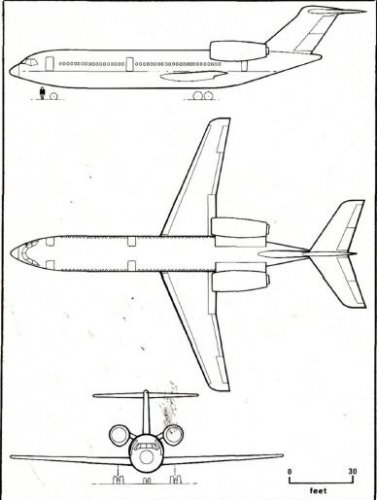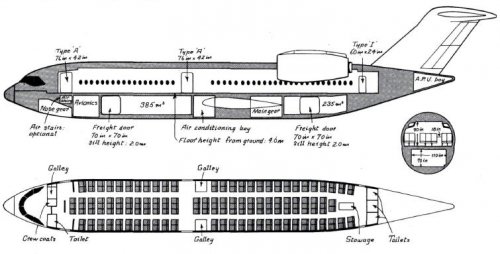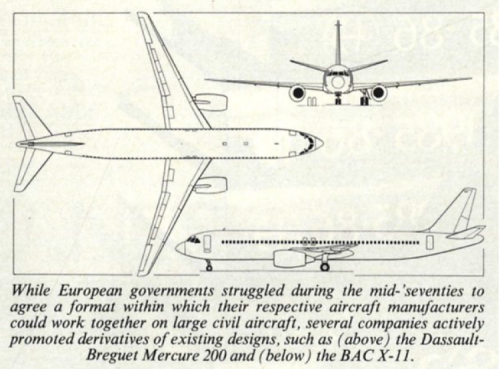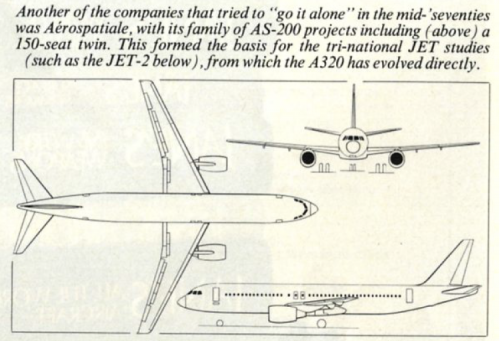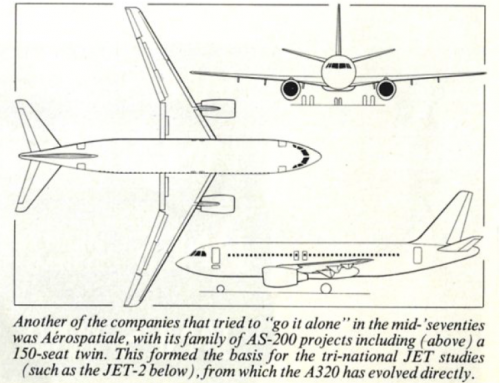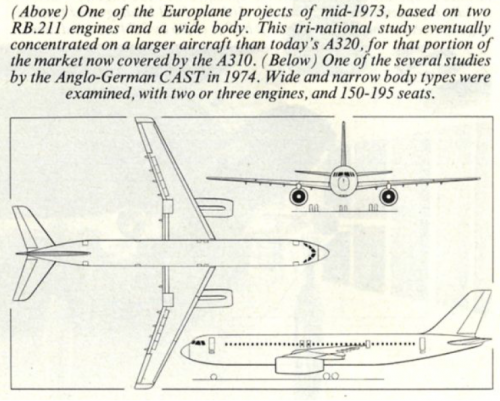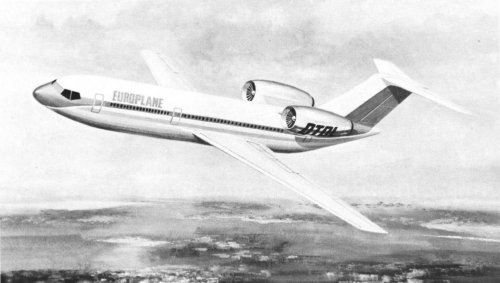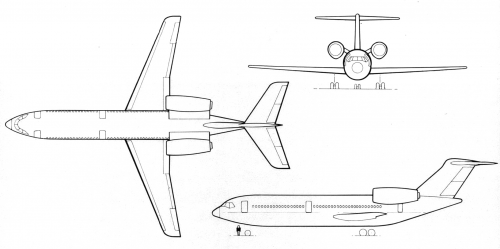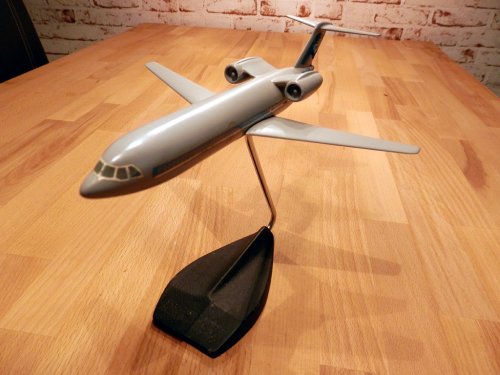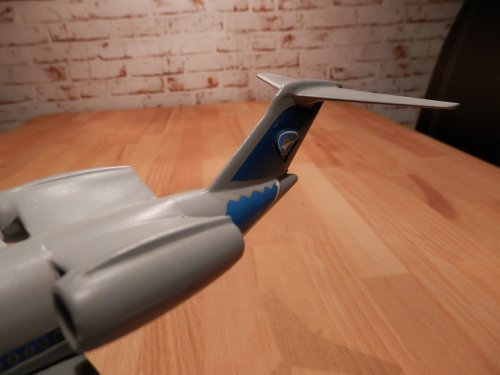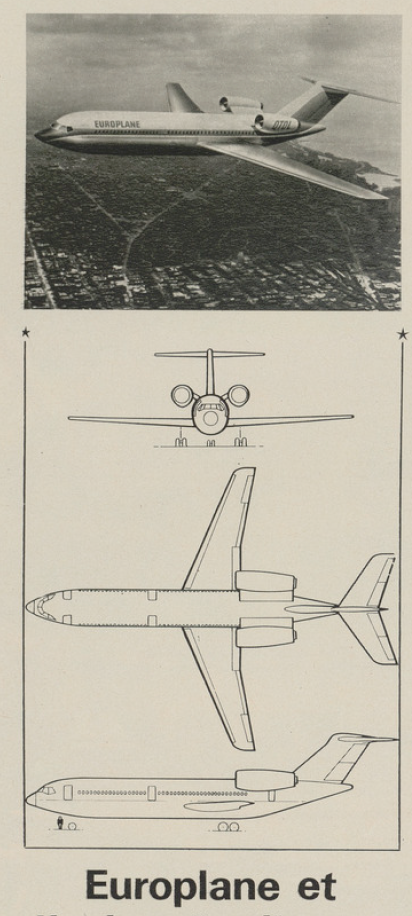Artist's conception of Europlane being developed by British, Spanish, Swedish and German companies shows rear mounted engines that use trailing edge of wing as noise shield during flyover. Engines are Rolls-Royce RB.21is with GE CF63 being offered as an alternative.
New European Twinjet Transport Studied
Manufacturers from U. K., Germany, Spain, Sweden are teamed for proposed 180-seat Europlane in the $13-million price range
Weybridge, England - First technical details on Europlane, a 180-seat twinjet transport under study by four European companies in a privately funded venture, indicate the airplane price will be in the $13-million range and that noise levels will be well below FAR Part 36 requirements. The aircraft has successfully completed two of three phases of a feasibility study and is now well advanced in the third, leading to a decision date of June, 1974, in which the companies’ governments will be asked for funding aid, and detailed design and engineering will begin.
Europlane is being studied by a 40-man team formed by British Aircraft Corp. (BAC), Construcciones Aeronauticas, SA (CASA) of Spain. Messerschmitt-Boelkow-Blohm (MBB) of Germany and Saab-Scania of Sweden. The team is headed by Board Chairman Werner Blohm of MBB, and eight directors, and directed by Chief Executive Kenneth Bentley of BAC, Technical Director Herbert Florsdorff of MBB, Finance and Program Director Jan Hull of Saab-Scania and Marketing Director John Prothero-Thomas of BAC.
Bentley said the design is aimed at 180 30" seats with the capability to bring the capacity to 200. Engines will be two Rolls- Royce RB211-22Bs, with General Electric
CF6 powerplants as an alternative. Both are in the 42,000lb. thrust range. Engines are aft-mounted on the upper fuselage just ahead of a T-tail to gain maximum benefit from noise shielding by the trailing edge of the wing.
Under the present program, the first flight is projected for 1977, and deliveries to customers will be in 1979. The airplane is sized to provide a logical growth from present-day fleets of 100-seat jet transports. The 180-200 seats will be fitted in a twin-aisle, seven-abreast in two-three-two configuration in single class. The basic design, which Bentley said is now in the refinement stage prior to wind tunnel testing, is the outcome of intensive investigation into a 60-seater with two or three engines, an 80-seat model with two, three or four engines and a 120-seat model, also with two, three or four engines. The final model of Europlane followed a study that showed that the fundamental cost per seat would be comparable with today’s jets in the l80-200-seat version, with two aft-mounted engines.
All European airlines also were interviewed as to timing, size, range and speed, and operations such as STOL and the analysis was a factor in determining Europlane parameters. The airplane will be offered as a conventional takeoff and landing design. Opinion of Europeans was generally shared by executives of Eastern, American, Allegheny and United airlines in the U. S. after Europlane executives had visited them.
One reason for the U. S. effort was, as Bentley said, to keep that important market advised of future developments in reequipment and also to gain some insight into American needs. The aircraft’s low noise profile of 90 pndb. and an airport noise footprint of 1-2 sq. mi. also are vital points in the initial design, which is aimed at bettering FAR Part 36 requirements.
In the 180-seat version. range will be 2,300 naut. mi., taking off from a 5.900-ft. runway, and, to offer flexibility. the same load will fly 500 naut. mi. from a 4.000-ft. runway.
Florsdorff said the design is aimed at proven state of the art. but with future improvements in instrumentation and avionics an integral part of design evolution. Flexibility concept also includes a design leading to operations on present airfield systems with 5 and 6 deg. approach angles, which reduce noise footprints and offer air traffic control flexibility.
Europlane team plans to stay with the RB211 and the CF6 alternative despite moves made by Rolls—Royce in development of its 22,000-30.000 lb. RB235 engine and GE/Snecma with the CFM56 on grounds that neither program is yet committed and significantly high development costs can be expected if they go ahead. Bentley also said it is doubtful the engines will be available within the schedule now established for Europlane. Prothero-Thomas said total market for the Europlane size category is estimated at about 1,350 aircraft by 1985.
Europlane Specifications
Design weights
Max. takeoff wt 242,500lb
Max. landing wt 220,500lb
Max. zero fuel wt 185,000lb
Max. payload 46,300lb
Typical operating wt. empty 138,700 lb
Fuel capacity 73,900lb
Dimensions
Span 124.5ft
Overall length 157.4ft
Overall height 42ft
Fuselage length 139.4ft
Wing area (gross). . 2,066 sq.
Passenger door sill ht 13.1ft
Freight door sill ht 6.6ft
Wheelbase 61ft
Track 26.2ft

